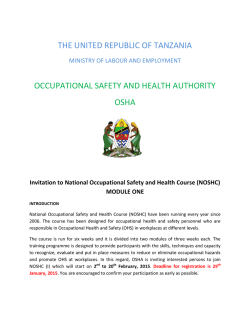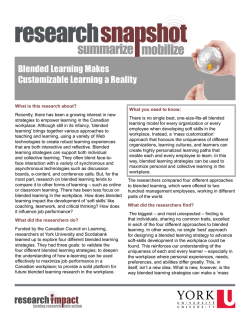
January Pulse - California Emergency Nurses Association
In this Issue: Message from the January 2015 Message from the President: Happy New Year! We have wrapped up an incredible year in the Sacramento ENA chapter with Sandy Piedra as our President. I plan to continue her focus on education and encouraging members to get involved. President 1 Chapter Update 1 Education Corner 1 Guest Article: Workplace Violence and Incivility: Advocacy for the Nursing Profession Through Change in Legislation As an ED Educator, I share a strong passion for great education within our chapter. We are planning dinner lectures, seminars, and possibly another simulation style education event. We also have ideas for community service projects for members to get more involved. As an extension of the National and California State ENA, we hope you will consider joining us at the State meetings and National Conference later this year in Orlanda, FL. This past year, we sent a very high number of delegates from our chapter to the National Assembly. This gives us a voice in voting for resolutions which shape our practice. There are also many excellent networking and learning opportunities. And plenty of fun! Jen Denno MSN, RN, CEN ENA Sacramento Chapter ENA President 2 Guest Article: Community Paramedicine 5 Upcoming Events 8 Education Corner: Cardiac 1) Name this rythym and what causes it: Chapter Update: 2015 Officers and Committees President: Jen Denno, [email protected] President-Elect: Jeremy Elrod, [email protected] Secretary/Treasurer: Lilla Szakacs, [email protected] Education Committee Co-Chairs: Mary Gannon, Jen Ruzicka Membership Chair: open 2) What are the FIVE lifethreatening complications of aortic dissection? 3) Why did Vincent Van Gogh use a lot of yellow late in his painting career? Newsletter Chair: open Government Affairs: open Do you want to get involved as a Committee chair? Contact Jen Denno for more details! See page 8 for the answers! Workplace Violence and Incivility: Advocacy for the Nursing Profession Through Change in Legislation December Stroble, BSN, RN, RNC-MNN, PHN I am a nurse and I have been a victim of assault by my patients… more than once… more than twice… So many times, I’ve lost count. And I am not okay with it. In 2012, I experienced a verbal and physical assault at the hands of a female patient, who was my height and weight. The patient, who had been sleeping on a gurney in the Emergency Department, woke in a very agitated state. Initially, I attempted to de-escalate the situation by addressing her concerns. Listening intently to what she wanted, I offered her several reasonable interventions. She refused them and in less than five seconds of my offer, the patient jumped off of the gurney and began charging towards me. With a wild look in her eyes, calling me every belligerent epithet known to man, I started to back away from her, but was unsuccessful. With a closed fist, she struck me in my clavicle, shoulder and chest, knocking me to the ground. I stood up, as the patient cocked her arm back to swing at me a second time. As she did this, Jason, an ED Tech saw what was happening, and reached his arm across me, pulling he and I to the ground. If she had landed that blow, I would have been struck in the temple, likely causing more significant injury. Security arrived to the Emergency Department and the patient was restrained immediately after the second assault. As a result of the incident, Jason suffered open scratches to his arm. We later discovered that the patient was Hepatitis C positive. I suffered bruising, contusions, pain, and decreased range of motion to my arm and shoulder. I required six weeks of physical therapy. These injuries are minor in comparison of those experienced by some of my colleagues. I called our local police department to have an officer dispatched to the Emergency Department and was told I could “file an online report” because no one suffered “grave bodily injury”. I explained several times to the dispatcher the situation and that I wanted to file charges against the patient. Each time I explained, I was met with “I’m sorry. There was no grave bodily injury, so there’s nothing we can do.” Workplace Violence is defined by the Occupational Safety and Health Administration (OSHA) as “Violence or the threat of violence against workers. It can occur at or outside the workplace and can range from threats and verbal abuse to physical assaults and homicide” As healthcare providers, our duty is to provide care to our patients under a myriad of circumstances. Violence and the threat of violence however, should not be one of those circumstances. According to the U.S. Bureau of Labor statistics, in 1999 there were, “2,637 nonfatal assaults on hospital workers”, and in 2010, an estimated 19% of workplace assaults occurred against nurses. This estimate is likely to be much higher, as “many more incidents probably go under reported” and the actual reported rates have tripled within the last decade. “Of all non-fatal injuries in the private sector in 2007, approximately 9,953 (59.1%) occurred in the health care”. Currently, the American Nurses Association (ANA) and Emergency Nurses Association (ENA), along with colleagues from the American Medical Association (AMA) and American College of Emergency Physicians (ACEP), are bringing awareness to the issue of workplace violence and incivility, and proposing action for legislative changes to ensure safer work environments for healthcare providers. Nationally, beginning in January 2015, the ANA Workplace Violence and Incivility panel, which includes participation from over 400 U.S. nurses, will begin developing a position statement to voice nursing’s standpoint on the issue. The position statement will be open for public viewing April 3-30, 2015, and pending ANA Board of Directors adoption, will be released August 17, 2015. In California, SB-1299 (Padilla) is a proposed Senate bill, which has been enrolled by the Senate and Assembly, seeking to protect California healthcare providers. The bill proposes that by July 1, 2016, Cal OSHA “adopt standards developed by the Division of Occupational Safety and Health that require specified types of hospitals, including a general acute care hospital or an acute psychiatric hospital, to adopt a workplace violence prevention plan as a part of the hospital’s injury and illness prevention plan to protect health care workers and other facility personnel from aggressive and violent behavior; The bill would require the standards to include prescribed requirements for a plan; The bill would require the division, by January 1, 2017, and annually thereafter, to post a report on its Internet Web site containing specified information regarding violent incidents at hospitals; The bill would exempt certain stateoperated hospitals from these provisions.” Specifics of the bill include changes to current California Health and Safety Codes; a definition of “workplace violence”; development of workplace violence prevention plans, training and education programs; changes to law enforcement reporting and investigation procedures; debriefing and psychological support resources for victims; annual analysis and assessment of factors contributing to incidents of workplace violence, such as staffing, security systems and security risks; provisions to protect providers wishing to seek treatment related to workplace violence, and prevention of hospitals taking punitive or retaliatory actions against providers subjected to violence who seek law enforcement or EMS assistance; requirements of hospitals to document and report to Cal OSHA all violent incidents against hospital employees and maintain those records for 5 years; and for all incidents to be available to the public, via the internet. ANA\C… California ENA, following suit of nursing colleagues in 31 other states, has drafted a bill proposing violence against healthcare providers to be punishable as a felony. With support from the California Chapter of American College of Emergency Physicians (Cal ACEP), members of CENA and Cal ACEP are currently seeking sponsorship of this bill from Senators Ted Gaines (R) and Dr. Richard Pan (D). Cal ACEP… As healthcare providers, our job is to give the very best care we can to our patients; In order to accomplish this, we must be able to do so in a safe environment. The proposed actions of ANA and ENA have begun to address the issues of workplace violence and incivility. With support from our fellow nurses, our voices are more likely to be heard and change can happen. Please contact your Assembly Person and Senator, and urge them to support healthcare providers in providing the best and safest care we can to our patients, by giving us safer workplaces. Encourage others to do the same. In the words of Margaret Mead, “Never doubt that a small group of thoughtful, committed citizens can change the world; indeed it’s the only thing that ever has.” 1 United States Department of Labor. Occupational Safety & Health Administration. (2002). OSHA Fact Sheet Workplace Violence. Retrieved from https://www.osha.gov/OshDoc/data_General_Facts/factsheet-workplace-violence.pdf 2 Centers for Disease Control and Prevention. (2014) . The National Institute for Occupational Safety and Health (NIOSH) Violence Occupational Hazards in Hospitals. Retrieved from http://www.cdc.gov/niosh/docs/2002-101/ 3 United States Department of Labor. Occupational Safety & Health Administration. Safety and Health Topics. Retrieved from https://www.osha.gov/SLTC/healthcarefacilities/violence.html 4 United States Department of Labor. Occupational Safety & Health Administration. Safety and Health Topics. Retrieved from https://www.osha.gov/SLTC/healthcarefacilities/violence.html 5 Janocha, J. A., & Smith, R. T. (2010, August 30). Workplace safety and health in the health care and social assistance industry, 2003-07. Retrieved from www.bls.gov/opub/cwc/sh20100825ar01p1.htm 6 California State Legislature. (2014). California Legislative Information. SB-1299 Workplace violence prevention plans: hospitals. Chapter 842. Retrieved from http://leginfo.legislature.ca.gov/faces/billNavClient.xhtml?bill_id=201320140SB1299 Lights, Sirens, and Landing Zones An EMS update for Emergency Nursing Paula Green RN BSN MS CCRN CFRN Wow! This is an exciting entry into 2015! Emergency health care may be at its most dynamic and changing moment that we have ever seen. As we roll over into a new year, we face changes in nation-wide health care policies, changes in reimbursement, changes in how we measure quality of care and changes in our patient care delivery system in the field. Community Paramedicine. Most of us have heard the term by now. If you aren’t exactly sure what Community Paramedicine is, the California Emergency Medical Services Authority (EMSA) provides a definition on the Community Paramedicine Fact Sheet that can be downloaded from: http://www.emsa.ca.gov/Community_Paramedicine It reads as follows: “Community Paramedicine (CP) is a model of community-based health care in which paramedics function outside their customary emergency response and transport roles in ways that facilitate more appropriate use of emergency care resources and enhance access to primary care for medically underserved populations. CP programs typically are designed to address specific local problems. Interest in community paramedicine has substantially grown in recent years based on the belief that it may improve access to and quality of care while also reducing costs.” It seems so long ago that I sat and listened to Dr. Kenneth Kizer present the findings from the Community Paramedicine report, Community Paramedicine: A Promising Model for Integrating Emergency and Primary Care, which was published in July of 2013. This report is what seemed to really spearhead the discussions of Community Paramedicine here in California even though areas of the country have been utilizing different forms of community-based health care for a number of years and have shown to be successful and sustainable. There has been great work behind the scenes over the last year in order for the State of California to test the concept of Community Paramedicine here in our golden state. There is much excitement in the EMS community as the announcement that 12 pre-selected pilot projects have received final approval to begin in January 2015. This approval comes from the Health Workforce Pilot Program under the Office of Statewide Health Planning and Development (OSHPD). EMSA describes the next steps: “Medical Director selected Paramedics will receive specialized training that builds upon the training and skill sets of experienced paramedics to include patient assessment, clinical skills and familiarity with the other healthcare providers and social services available in a local community, and will lead to a more integrated approach to health care delivery. Community paramedics will work under physician direction and approved patient care protocols to ensure patient safety while providing the right level of care for each patient. OSHPD and EMSA have convened a Statewide Advisory Committee to provide oversight of the pilot program to ensure patient safety.” According to the EMS Authority, pilot sites will be in Alameda, Butte, Los Angeles, Orange, Santa Barbara, San Bernardino, San Diego, Stanislaus, Solano and Ventura Counties. These sites will utilize community paramedics to offer services including: follow up care for patients recently discharged from the hospital; transportation to urgent care or mental health clinics; hospice support; follow up treatment of tuberculosis; and assist individuals who frequently utilize emergency medical services to establish care with a primary care physician. A listing of pilot sites, partnering medical providers and services provided is available at http://www.emsa.ca.gov/Community_Paramedicine. This is absolutely an exciting time! Could these programs be the answer to decreasing patient returns to the ED after discharge? Could it provide greater access to patient populations with identified lack of access to healthcare? Could it be the answer to decreasing Emergency Department visits overall because patients can be transported to more appropriate facilities or be treated and released on scene? It sounds hopeful that it could be the answer to many identified problems. As we wait and watch the process unfold, it is important to note that there are still many questions and concerns from the healthcare community and its stakeholders. There are valid questions regarding quality assurance, medical control, reimbursement, appropriate destinations, paramedic skills, training and capacity, data gathering, needs of urban vs. rural areas, and sharing of protected health information. Community Paramedicine has finally hit California and its time for us to take a look at its feasibility, efficacy, safety and sustainability. As emergency nurses, we play a vital role in the contribution of assessment and evaluation both formally and informally. There is no better time than now to get involved with the future of health care within our own community. Community Paramedicine may be the answer to our prayers; and on the flip side, we may find there is an alternative matrix to providing community-based health care that better meets the needs that have been identified in the geographic areas that we serve. There are many unknowns as we search for answers on how California’s CP pilot projects will turn out. But, there is one thing that is for sure. Emergency health care is dynamic and is changing - so get ready, put your seat belt on and embrace the ride into 2015! Information on California’s Community Paramedicine Programs can be obtained from the California Emergency Medical Services Authority website at: http://www.emsa.ca.gov/Community_Paramedicine Everyone is welcome to CA ENA State meetings! The next one will be in Oakland on Jan 8 and 9. Visit the website for more details. www.calena.us Do you want to write for the newsletter? We want to hear from you! Send us your hot topics, education items, clinical pearls, or anything you think other ED nurses might benefit from reading about! Topic Place Date/Time Toxicology: G. Patrick Daubert, MD, FACMT Dinner meeting: Adasuve, inhaled loxapine Kaiser South Conference room 1 and 2 TBA Jan 28, 2015 6-8pm 5150/1799 for ED Nurses Sutter Conference Center Sutter Conference Center Trauma Care After Resuscitation (TCAR) (tentative) March 4, 2015 6-8pm March 25, 2015 6-8pm (tentative) June 9 and 10, 2015 Answers (from page 1): 1) Rhythm: Osborne wave, caused by hypothermia 2) Coronary dissection, usually the right coronary artery (RCA) causing inferior ST elevation MI • Carotid dissection causing stroke • Aortic rupture • Cardiac tamponade from rupture into pericardium • Acute aortic valve regurgitation causing cardiogenic shock 3) Vincent Van Gogh (the artist) was toxic on digoxin (he used the flower foxglove for a seizure disorder) and this is why he painted everything yellow before he reportedly committed suicide.
© Copyright 2026
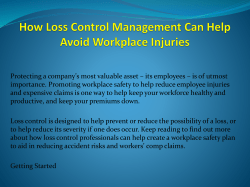
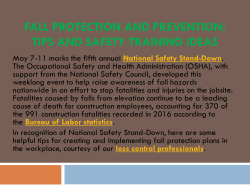
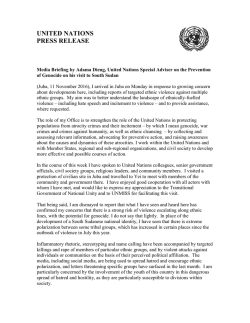
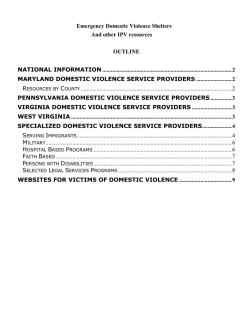
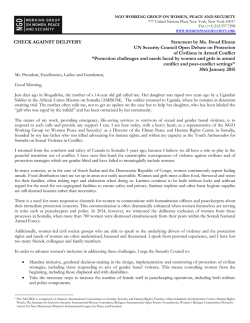
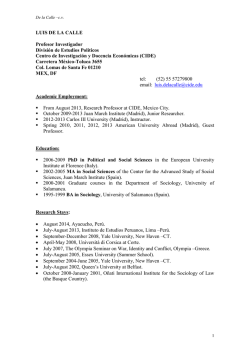
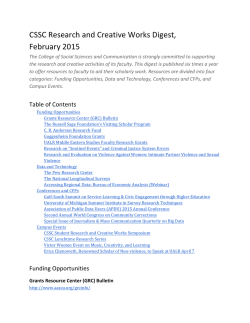

![[Click here and type place and date] - EMSA](http://s2.esdocs.com/store/data/000467641_1-f802c01f4a8923c9324d9c92cefbeb6b-250x500.png)
